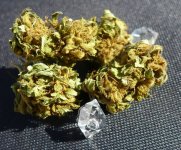Deach69
2022 COE Winner
Thanks for chiming in @longball . I'll try cutting it off next year, see what happens. It tends to go away soon after and I can't tell if it affects the taste or strength. My main concern is that any seed I make out of these outdoor plants may hold the possible virus causing this stuff
I think there is one commonality that could lead to an answer. The fact that it tends to begin as flowering begins as well as the color, dark purple which would show a specific deficiency ocurring at this point of maturation.
@59lespaul , have you learned anything new?
I think there is one commonality that could lead to an answer. The fact that it tends to begin as flowering begins as well as the color, dark purple which would show a specific deficiency ocurring at this point of maturation.
@59lespaul , have you learned anything new?

